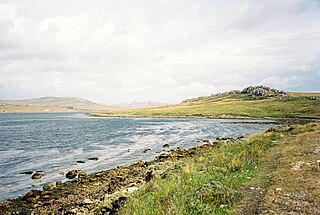 W
WThe Invasion of the Falkland Islands, code-named Operation Rosario, was a military operation launched by Argentine forces on 2 April 1982, to capture the Falkland Islands, and served as a catalyst for the subsequent Falklands War. The Argentines mounted amphibious landings and the invasion ended with the surrender of Falkland Government House.
 W
WThe Bluff Cove air attacks occurred 8 June 1982, during the Falklands War. British troop transport ships were bombed by the Argentine Air Force (FAA) whilst unloading, with significant damage and casualties.
 W
WThe Battle of Goose Green was an engagement between British and Argentine forces on 28 and 29 May 1982 during the Falklands War. Located on East Falkland's central isthmus, the settlement of Goose Green was the site of an airfield. Argentine forces were in a well-defended position, within striking distance of San Carlos Water, where the British task force had made its amphibious landing.
 W
WThe Battle of Mount Harriet was an engagement of the Falklands War, which took place on the night of 11/12 June 1982 between British and Argentine forces. One of three battles in a Brigade-size operation all on the same night, the other two being the Battle of Mount Longdon and the Battle of Two Sisters.
 W
WThe Assault on Mount Kent was a series of engagements during the Falklands War, primarily between British and Argentine special forces.
 W
WThe Battle of Mount Longdon, on 11–12 June 1982 near the end of the Falklands War, was fought between the British Third Battalion, of the Parachute Regiment and elements of the Argentine 7th Infantry Regiment, one of three engagements in a Brigade-size operation that night, along with the Battle of Mount Harriet and the Battle of Two Sisters. A mixture of hand-to-hand fighting and ranged combat resulted in the British occupying this key position around the Argentine garrison at Port Stanley.
 W
WThe Battle of Mount Tumbledown was an engagement during the Falklands War. Mount Tumbledown, Mount William and Sapper Hill lie west of the Falkland Islands capital Stanley and due to their proximity to the capital, were of strategic importance during the 1982 War. They were held by the Argentine 5th Naval Infantry Battalion, a reinforced, cold weather trained and equipped, Marine battalion.
 W
WOperation Paraquet was the code name for the British military operation to recapture the island of South Georgia from Argentine military control in April 1982 at the start of the Falklands War.
 W
WThe Raid on Pebble Island was a raid by British Special Forces on Pebble Island's airfield during the Falklands War, and took place on the night of 14–15 May 1982. Pebble Island is one of the smaller Falkland Islands, lying north of West Falkland. The site was being used as a forward operating base for T-34 Mentor and Pucara aircraft by the Argentine Air Force; British Special Air Service (SAS) operatives were tasked with destroying the aircraft on the ground, in an operation that echoed back to some of the unit's first missions during the North African Campaign of World War II. SAS elements, then embarked on HMS Hermes, were tasked with eliminating the airfield, with naval support from the Type 22 frigate HMS Broadsword as Hermes defensive escort and the County class destroyer HMS Glamorgan to provide naval gunfire support with its Mark 6 4.5 inch guns.
 W
WThe Battle of San Carlos was a battle between aircraft and ships that lasted from 21 to 25 May 1982 during the British landings on the shores of San Carlos Water in the 1982 Falklands War. Low-flying land-based Argentine jet aircraft made repeated attacks on ships of the British Task Force.
 W
WThe Battle of Seal Cove was a minor naval action west of Lively Island, during the 1982 Falklands War. On 22 May 1982, while supporting Operation Sutton off San Carlos Bay, the British frigates HMS Brilliant and HMS Yarmouth received orders to stop and seize the Argentine Navy armed coastal supply boat ARA Monsunen.
 W
WOn 10 June 1982, in the closing days of the Falklands War, Many Branch Point, a ridge near Port Howard in West Falkland, was the site of a minor skirmish between the Argentine and British Armed Forces. The engagement ended with the death of the SAS patrol commander, Captain Gavin Hamilton. The action was the only land engagement of the British and Argentine forces on West Falkland during the conflict.
 W
WThe invasion of South Georgia, also known as the Battle of Grytviken or Operation Georgias, took place on 3 April 1982, when Argentine Navy forces seized control of the east coast of South Georgia after overpowering a small group of Royal Marines at Grytviken.
 W
WThe Skirmish at Top Malo House took place on 31 May 1982 during the Falklands War, between 1st Assault Section Argentine Special Forces from 602 Commando Company and a patrol formed from staff and trainees of the British Mountain and Arctic Warfare Cadre, a training detachment of the Royal Marines who were under the Control of 3 Commando Brigade for Operation Corporate.
 W
WThe Battle of Wireless Ridge was an engagement of the Falklands War which took place on the night from 13 June to 14 June 1982, between British and Argentine forces during the advance towards the Argentine-occupied capital of the Falkland Islands, Port Stanley.